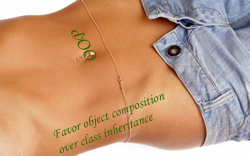 Show Me the Practical!
Show Me the Practical!
A defining characteristic of PHP programmers is their practicality. Ironically, because of their practical orientation, they sometimes overlook the practicality of the abstract and conceptual. Focusing too much on a single (albeit quite useful and practical) implementation is like focusing on a single pixel in a graphic image—you can only see the pixel and miss the larger picture. That’s because the focus is in the wrong place. If you want to see the whole picture (the whole pattern and its parts), the individual pixels are not very practical, even though they are the atomic matter in computer graphics. In other posts on this blog, I have stressed the importance of having a complete design pattern with all of the participants a given design pattern is designed to include and provided a look-up table to check the parts list of all of the core patterns the Gang of Four developed. So in selecting an example to launch a discussion of the Composite pattern, I wanted an example with all of its parts. You can download the files and play a sample using the following two buttons:
![]()
![]()
However, too much of a love affair with the conceptual and abstract is equally problematic. If you cannot use a pattern to get something accomplished, why waste time with it? Ironically, design patterns were developed solely for practical purposes, but in order to accomplish those practical goals, they had to provide a set of patterns that would be useful for a wide range of certain recurring programming problems. With these concepts in mind, this post begins with a conceptual example to see how the pattern works and then follow it up with a simple more practical example.
Overview
First things first. The class diagram for the Composite design pattern is both very simple, but it hides a real beauty and subtle complexity. Figure 1 shows the basic pattern:

Figure 1: Composite Design Pattern class diagram
Before going too far with an example, even an abstract one, consider the simplicity and irony of the pattern. First of all, the Composite implementation of the Component interface looks fairly cut and dried. However, the Leaf participant also implements the interface, but it doesn’t implement all of the abstract methods. It only implements the operation(). So maybe the interface is an abstract class? It doesn’t matter in PHP. If all of the abstract methods of a class that inherits an abstract class are not implemented, you get the following error:
Fatal error: Class Leaf contains 1 abstract method and must therefore be declared abstract or implement the remaining methods
Since you can only declare an abstract method within an abstract class, you really have no choice but to implement it. Likewise with an interface all methods must be implemented; so with this first abstract example, I decided to use an interface instead of an abstract class.
Favoring Composition: A Tattoo for Your Spouse
One of the fundamental principles of design patterns is,
Favor object composition over class inheritance.

Figure 3: Tats for PHP Developers
For the longest time, that simple yet fundamental idea eluded me. In part, this was due to the Gang of Four’s intent statement that the pattern was to Compose objets into tree structures to represent part-whole hierarchies. I was too focused on the concept of hierarchy and not enough on compose to really appreciate the importance of the Composite design pattern.
So here, the first thing to do is to realize that the hierarchy is a form of composition. Imagine an automobile assembly plant where you have lots of parts, yet with those parts you can assemble different models of cars. You just have to use different selections of parts to compose the different models. The fact that the parts have a hierarchic arrangement is for efficiency; not the final product itself. Figure two shows what we hope to create in this initial implementation:

Figure 2: Different Compositions from Leaf Selections
Continue reading ‘The Composite Design Pattern in PHP: Part I from Conceptual to Practical’
Recent Comments